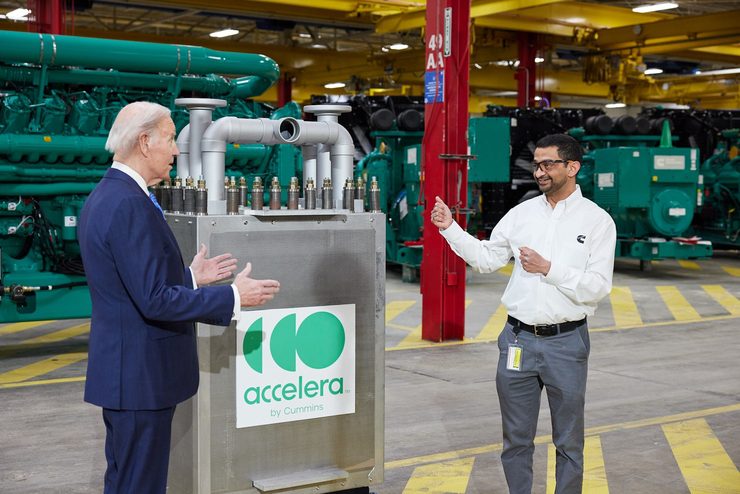Hydrogen Offers a ‘Multi-Billion-Dollar Opportunity’ This Decade for Innovative Companies
Hydrogen demand throughout the world reached 94 million metric tons in 2021, according to the International Energy Agency’s (IEA’s) Global Hydrogen Review 2022, an annual report issued by the IEA in late September last year. Demand for new applications grew to about 40,000 metric tons (up 60% from 2020, albeit from a low base).
Notably, the IEA said some key new applications for hydrogen are showing signs of progress. Announcements for new steel projects are growing fast, according to the agency, just one year after the startup of the first demonstration project using pure hydrogen in direct reduction of iron. Furthermore, the first fleet of hydrogen fuel cell trains started operating in Germany. There were also more than 100 pilot and demonstration projects reported using hydrogen and its derivatives in shipping, and the IEA noted that major companies have already signed strategic partnerships to secure the supply of these fuels.
In the power sector, the use of hydrogen and ammonia is also attracting a lot of attention. The report says announced projects stack up to almost 3.5 GW of potential capacity by 2030.
With the future for hydrogen looking so bright, it’s no wonder companies are moving quickly to take advantage of the opportunity. Accelera, a new brand launched in March this year as part of Cummins’ New Power business segment, is among the companies hoping to cash in on the growth in hydrogen. It opened its first U.S. electrolyzer manufacturing plant in Fridley, Minnesota, with a ribbon-cutting ceremony on May 19.
“Fridley was basically the fastest way for us to get capacity on stream quickly,” Alex Savelli, managing director of Hydrogen Technologies for Accelera, said as a guest on The POWER Podcast. “We announced it in October and we had the ribbon-cutting in May, so within six months.”
While the Fridley site was a “brownfield” project, meaning it was built where Cummins already had an existing facility, Accelera is also building “greenfield” projects in other parts of the world. “There are a couple of sites that we’ve actually selected 18 months ago to be built in Spain and China,” Savelli said. “They’re greenfield sites, and from beginning to completion, it probably will take two years before they’re up and running.”
President Biden visited the Fridley facility on April 3 this year as part of a tour (Figure 1) intended to showcase how the Bipartisan Infrastructure Law and Inflation Reduction Act (IRA) are benefitting American manufacturing jobs. It was just two months after Biden signed the IRA that Cummins announced it would begin manufacturing electrolyzers at its Fridley location, which now has about 89,000 square feet dedicated to electrolyzer manufacturing.

“Quite a bit of that decision in a lot of ways was supported by some of the good policies that the current administration has put in place with the Infrastructure Bill as well as the Inflation Reduction Act,” said Savelli. “They have certainly underpinned our decision even more strongly. Since then, we have seen demand really pick up.”
Most of the hydrogen used around the world today is produced through steam methane reforming using natural gas as the feedstock, which releases carbon dioxide in the process. This is often referred to as “gray hydrogen.” Electrolyzer technology offers a way to produce “green hydrogen,” which is carbon-free and could help hard-to-decarbonize industries become more sustainable. To produce green hydrogen, renewable resources are used to power electrolyzers.
“We think with the challenges around climate change and what we need to achieve to actually get to net-zero, hydrogen would definitely be one of the big elements there,” said Savelli. “It will become a multi-billion-dollar opportunity—whether it’s here in the Americas, in Europe, or other places—between now and the end of the decade.”
To hear the full interview with Savelli, which includes more about government incentives designed to spur growth in hydrogen; projects in operation today with Accelera electrolyzers, including the largest plant in the world utilizing proton exchange membrane (PEM) technology in Quebec, Canada; three items that should be addressed to help ensure the success of the new hydrogen economy; other technology that Accelera is focused on, including fuel cells; and more, listen to The POWER Podcast. Click on the SoundCloud player below to listen in your browser now or use the following links to reach the show page on your favorite podcast platform:
For more power podcasts, visit The POWER Podcast archives.
—Aaron Larson is POWER’s executive editor (@AaronL_Power, @POWERmagazine).